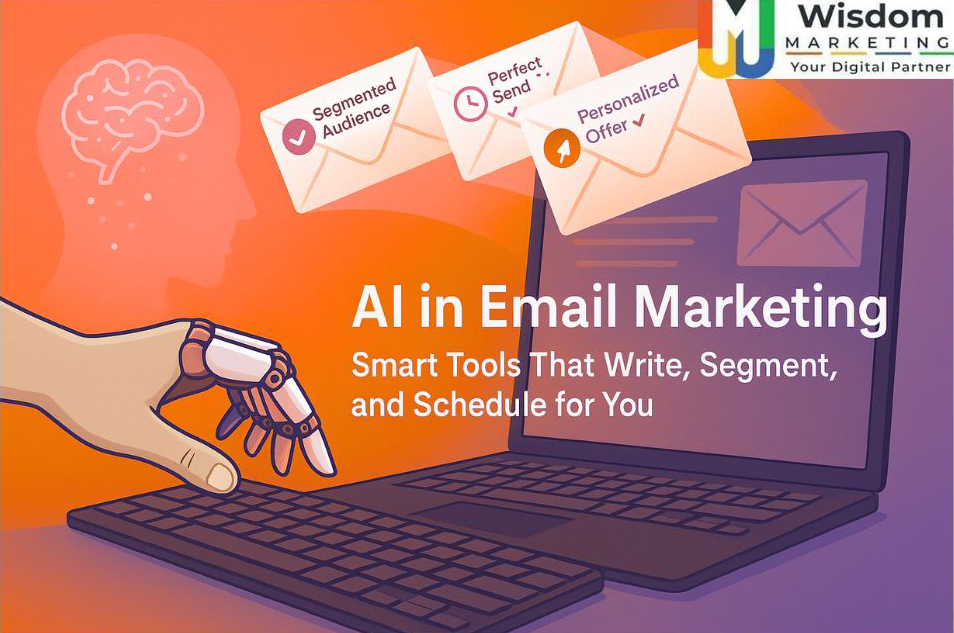AI in Email Marketing: Smart Tools That Write, Segment, and Schedule for You
Email marketing has always been a powerful tool for connecting with customers. But with inboxes more crowded than ever, sending the right message at the right time to the right person has become both more important and more difficult. That’s where artificial intelligence (AI) steps in—not to replace marketers, but to make their work faster, smarter, and way more effective.
From writing compelling subject lines to sending emails at exactly the right moment, AI is transforming how we do email marketing. In this blog, we’ll explore how smart AI tools are changing the game by writing emails, segmenting lists, and scheduling campaigns—all while saving marketers time and boosting engagement.
1. Writing Emails That Actually Get Opened
Let’s face it—staring at a blank screen trying to craft the perfect email is no fun. And even when you think you’ve nailed it, there’s no guarantee people will click. That’s why many marketers are turning to AI copywriting tools.
How It Works:
AI-powered writing tools like ChatGPT, Jasper, and Copy.ai can help marketers:
- Generate catchy subject lines
- Suggest email content based on product descriptions
- Personalize content for different audience types
- Improve tone, clarity, and grammar
You don’t have to use the content as-is, but these tools give you a solid first draft. That means you can spend more time fine-tuning your message instead of wrestling with writer’s block.
Real-Life Example:
An e-commerce brand selling fitness gear used AI to test 10 different subject lines. The AI-generated line—“Get Fit Fast: 25% Off Gear This Week Only”—had a 27% higher open rate than the one written by a human.
2. Smarter Segmentation Without the Hassle
Most marketers know the importance of segmenting email lists. Sending the same message to your entire list is like giving everyone the same birthday gift—it won’t work for everyone.
But manual segmentation is a time-consuming task. You’d need to analyze data, sort users by behavior or demographics, and then create custom lists.
AI Makes It Easier:
Modern AI platforms automatically group your subscribers into meaningful segments by analyzing their:
- Purchase history
- Browsing patterns
- Email engagement (opens, clicks)
- Location, age, interests, etc.
This allows you to send hyper-targeted messages—like offering a winter coat to someone in Chicago while promoting sunglasses to someone in Miami.
Bonus: Predictive Behavior
Some AI tools even go a step further by predicting future actions. For example, they might flag users who are likely to unsubscribe or those who are ready to buy again—so you can tailor your emails accordingly.
3. Perfect Timing With AI Scheduling
When’s the best time to send your email? Monday morning? Friday afternoon? The truth is, there’s no one-size-fits-all answer. Every subscriber is different.
AI to the Rescue:
AI scheduling tools analyze past behavior to figure out when each subscriber is most likely to open and click on your emails. Then, it schedules the send time accordingly.
Instead of sending one blast to your entire list, the system delivers each email at the optimal time for that individual.
The Result?
More opens, more clicks, and fewer unsubscribes—without you lifting a finger.
4. AI-Powered A/B Testing
Traditionally, A/B testing requires running multiple tests, analyzing data, and waiting days for results. With AI, this process becomes lightning-fast and smarter.
AI tools can:
- Run multiple variations of subject lines, calls to action, and images
- Predict which version will perform best before the email even goes out
- Automatically optimize future emails based on real-time performance
This means you’re always improving your email strategy without manually crunching numbers.
5. Personalization That Goes Beyond “Hi [First Name]”
Today’s customers expect emails that feel tailored to them. Basic personalization isn’t enough anymore. Thankfully, AI can create dynamic content that feels almost one-on-one.
For example:
- Product recommendations based on browsing behavior
- Customized email journeys for different buying stages
- Smart insertion of personalized offers and coupons
AI can even rewrite parts of an email for different reader personas—like casual browsers, loyal customers, or first-time buyers.
6. Affordable and Accessible
You don’t need a huge marketing team or budget to benefit from AI. Many email marketing platforms already include AI features, such as:
- Mailchimp: Offers AI-generated subject lines and smart send time optimization
- HubSpot: Uses AI for lead scoring and behavior-based segmentation
- Sender: Suggests email content and layout optimization
- ActiveCampaign: Personalizes email content and sends based on predicted engagement
These tools often have free or affordable tiers, making AI accessible to small businesses and startups as well.
7. Is AI Replacing Marketers?
Nope. AI isn’t here to take over your job—it’s here to make it easier. Think of AI as your smart assistant. It helps with the heavy lifting, so you can focus on creative strategy, storytelling, and building real relationships with your audience.
Humans still bring the emotion, intuition, and branding that AI can’t replicate. But AI helps you deliver that human message more efficiently and accurate
Final Thoughts
AI in email marketing isn’t some distant future—it’s happening right now. If you’re still doing everything manually, you’re working harder than you need to.
With smart tools that write, segment, and schedule for you, you can:
- Save time
- Increase engagement
- Personalize every message
- Drive more sales
Whether you’re a solo entrepreneur or a growing brand, integrating AI into your email strategy is a smart move. The best part? You don’t need to be a tech expert to get started.


